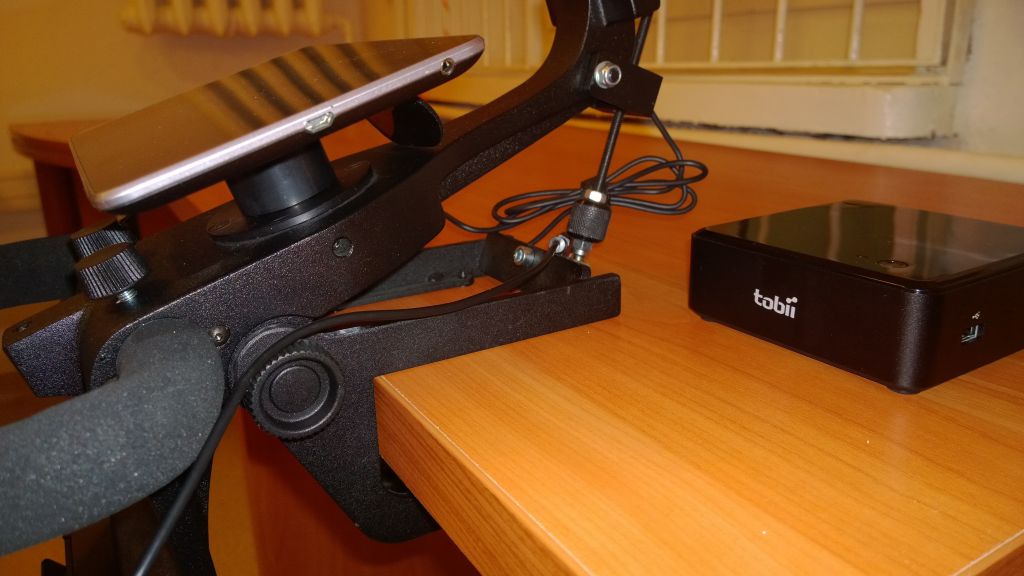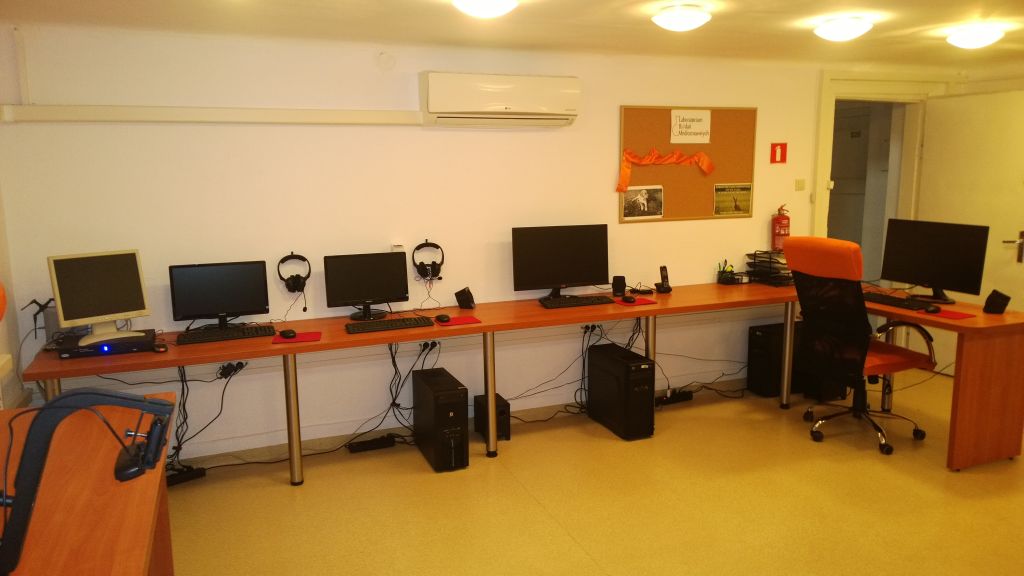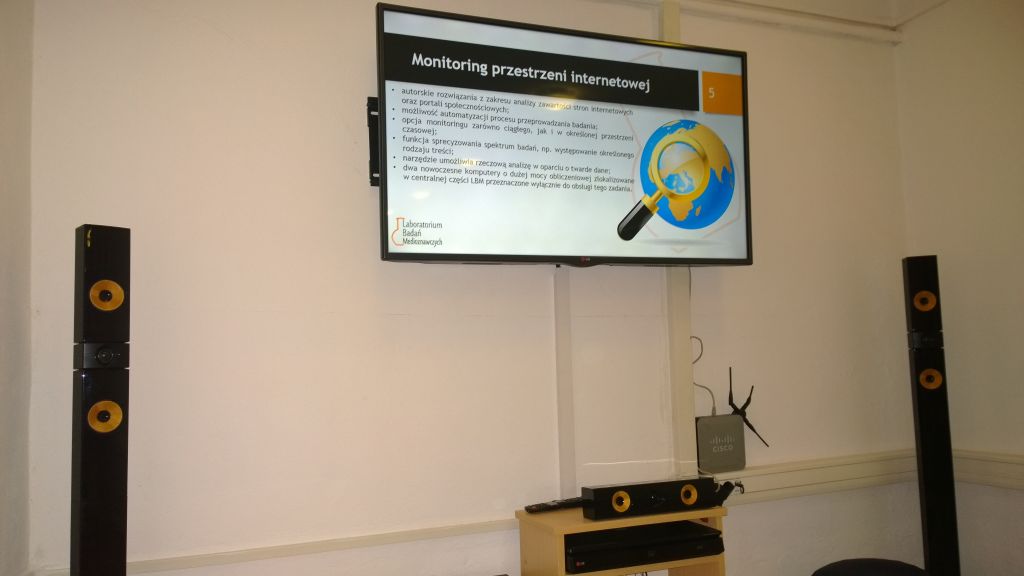Technology and equipment provide about the functionality of Laboratory of Media Studies: 2x8-core server processors, ultra-fast internet access, several radio and television channels real time recorder, specialised software, but above all the most modern eyetracker - device to test eyeballs movements.
 I. Server – HP DL380p gen8
I. Server – HP DL380p gen8
- 2x8-core server processors Intel Xeon;
- 96 GB RAM;
- 13,2 TB internal storage;
- two power supplies;
- UPS;
- server hosts internet portals;
- access to multimedia resources and research materials for scientists;
- surveys platform;
- big database able to store : 10k hours of record videocontent, 350k text publications, 32k hours of audiocontent, 116k FullHD photos.
 II. Eye Tracker and Mobile Device
II. Eye Tracker and Mobile Device
- Eye Tracker X2 TOBII 60 – the most modern eye tracker, TOBII Studio 3.4.3 software and superfast ASUS laptop;
- Mobile Device – special arm to mobile device applications usability test;
- the newest solution to test eyeballs movements during use of media - text, tv advertaisment, movie, poster, website, application and more;
- allow to carry out research, eg. types of medium usage quality, in effect reccomend their optimalized - usabiliy tests;
- comprehensive usability tests of mobile phones and tablets;
- small size of the equipment allows to use if outside the laboratory, eg. in a more natural environment for the test.

III. Web crawling
- proprietary solution in the field of content analysis of websites and social media;
- the ability to automate process research;
- precis types of content identifacation;
- two web crawling powerful computers;
- full automatic of data aggregation;
- semi-automatic coding;
- extensive analysis;
- virtual ethnography - cultural network - web 2.0 and 3.0).
 IV.TV and radio monitoring
IV.TV and radio monitoring
- several radio and television channels real time recorder – supported by Stirlitz Media Software;
- the number of channels can be extended with the technological and personal development of Laboratory of Media Studies;
- database allows to make dedicated archives containing materials with specific events and carrying them for further analysis;
- access to materials for research purposes from both - presence in the laboratory and remotely
- easily build a remote research groups, eg. research gruop work from home;
- thematic, problem, incidental and continuous monitoring;
- quality coding in research teams and semi-automatic language recoding - quantitative transcription, automatic and semi-automatic transcription;
- automatic image recognition - in process.
 V. CATI, CAWI, CASI
V. CATI, CAWI, CASI
- CATI studio - able to use as part of CASI - computer assisted self interviews;
- 15 complete computer desks;
- low energy and mini computers - one desktop takes only less than 42W power;
- very quiet work of computer to make telephone surveys more effective;
- all computers run on Microsoft Windows 10;
- random digital-dialing software to computer assisted telephone interviews;
- CATI studio can be used to experimental tests requiring computer support;

VI. FGI studio
- 50" interactive, the newest TV with Blue-ray player and HD camera make possible to perform multimedial shows in 2D and 3D technologies.
- specially arranged studio (equipped with Venetian glass and several colorful poof) create an intimate, unique atmosphere for respondents;
- possibility of carrty out ProfFGI (with experts, specialists);
- studio can be used as a training room;
- studio enable to make pre-release screening of a film analysis with record of brainstorm after show.

VII. Projection room
- 50" interactive, the newest TV with Blue-ray player and HD camera make possible to perform multimedial shows in 2D and 3D technologies;
- home theater system;
- hybrid TV technology cooperating with wiraless solutions and streaming systems;
- room enable to do advertisment tests - also using Eye Tracker X2 TOBII 60;
- tests videocontent published on eg. YouTube, Vimeo
- tests SD vs. HD and 3D;
- visual preparing to FGI;
- possibility of carry out advanced training and expert workshops.
 VIII. Techologies - full compatiblity
VIII. Techologies - full compatiblity
- Laboratory of Media Studies is full of advanced technologies, which are compabile with each other;
- the most important in compatibility is super fast cable and wiraless internet access;
- all the computers work on the basis of processors Intel Haswell and Ivy Bridge;
- easy share functions by using wiraless technologies eg. DLNA, Intel WiDi, Bluetooth;
- TV and monitor displays on the basis of LED technology - very good quality and low energy consumption;
- Laboratory of Media Studies is possible to design and perform a specific research project (due to the given problem), but also to organize and carry out the process of implementing changes and recommendations.
 IX. The newest software
IX. The newest software
- LBM has programs useful during research activities and further processing and publication;
- Adobe CS6 - set of different Adobe application for designing, animation and other multimedia activities;
- Camtasia Studio 8's TechSmith - advanced software to create video instruction and training materials;
- Microsoft Office 2013 allow to make all office operations, further enhanced by group work together on common documents and storage resources in the "cloud";
- if it is possible Laboratory of Media Studies use open-source software, cuurently has:
- – Debian Linux Server on the main server of Laboratory of Media Studies;
- – Office suite LibreOffice as a complement to Microsoft Office 2013 in the range of accurate and full service open formats of electronic documents.
 X. Books and newspapers monitoring
X. Books and newspapers monitoring
- Polish researchers could instantly browse newspapers and books from the period in terms of their interest phrases, contexts, statements, descriptions. Ultimately Laborratory of Media Studies also would create a library of the most important positions, including foreign languages.
XI. Databeses